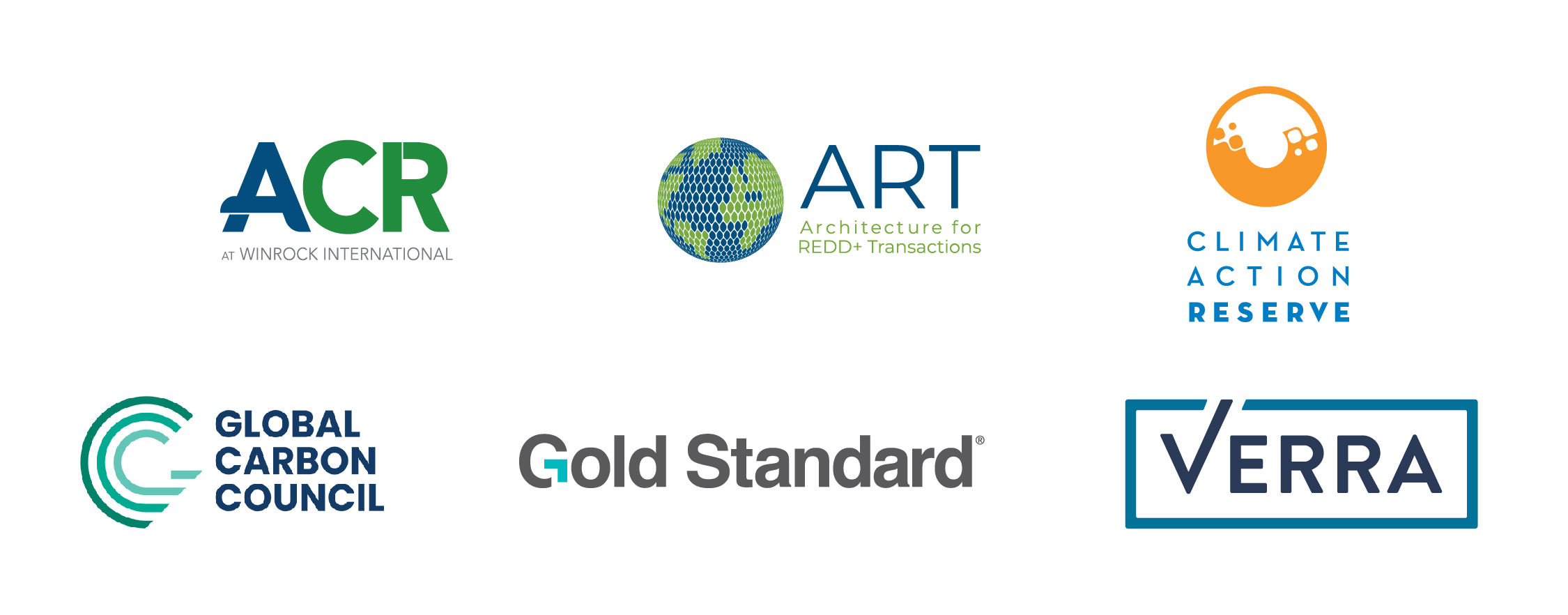The China Adipic Acid Production Protocol addresses nitrous oxide (N2O) emission reductions at adipic acid production facilities in China. With N2O having a global warming potential 273 times that of CO2, the protocol aims to incentivize the installation and use of N2O emission control technology to achieve significant N2O emissions reductions.
Promoting scale and integrity in carbon markets to help operationalize Article 6 and Nationally Determined Contributions under the Paris Agreement
COP 28, Dubai
An integrity collaboration of independent carbon crediting programmes
Independent crediting programmes are joining forces to amplify the impact of carbon markets in mitigating climate change and supporting countries in implementing Article 6 and their Nationally Determined Contributions. Our programmes have long proven the ability of robust monitoring, reporting and verification to channel finance and promote mitigation across a vast range of opportunities. We share the urgency of scaling up the flow of finance over this decade and beyond.
Carbon markets have been a critical driver of private sector investment in tangible climate action in developing countries for over 20 years. Markets have led efforts to discover mitigation opportunities, propel innovation, and rally resources and know-how to step up the momentum of change. This is only increasing. Around US$36 billion has been invested via carbon crediting projects over the past decade, with almost half of this invested since 2021 when Nationally Determined Contributions (NDCs) took effect under the Paris Agreement.1 This is vital in an environment in which finance for developing countries’ mitigation efforts remains scarce. The private sector is ready and willing to grow its provision of finance and needs concrete, credible frameworks to underpin its quality and public acceptance.
Independent carbon crediting programmes ensure high integrity in mitigation activities and the emission reductions and removals they generate. Many of us bring decades of experience in enabling the private sector to mobilize finance. The credits we issue are from real, additional, durable and verified mitigation outcomes. We strive to reinforce the quality of our crediting programmes where new scientific or technological advances offer opportunities for elevating rigour. For this, we have learned much over these decades and we now leverage this experience to continuously improve our standards, methodologies, systems and processes.
The way credits are used is undergoing a transformation. Businesses are increasingly retiring credits to compensate for their emissions alongside their work to decarbonize their operations and make net zero a reality, by 2050 at the latest but for many companies much earlier. In fact, a growing body of research shows that companies using carbon credits decarbonize their own emissions twice as fast as those that do not.2 New models to frame the use of credits as contributions to country or global mitigation are also emerging. In host countries, projects have always left behind positive impacts that multiply mitigation results beyond what is credited. Such impacts are intensified by host communities and governments receiving a portion of the project benefits and reinvesting these in tangible action to further mitigate emissions and support sustainable development. Credits are also being integrated with carbon taxes and other regulatory compliance programmes in the context of Article 6.
Countries can integrate the use of independent crediting programmes, saving the need to build and maintain their own programmes and allowing them to focus on setting their priorities for investment and sustainable development. The challenges we confront in enabling finance and ensuring integrity are the same as those that governments face. Using these crediting programmes accelerates countries’ mitigation efforts and assists them in achieving their NDCs.
To enable their use for these purposes, independent crediting programmes have added frameworks for authorizing mitigation outcomes under Article 6. We work to align with emerging methodological and reporting requirements under the Paris Agreement and to tailor our work to tie in with host country systems and processes. We seek to keep these measures simple and available for use by all countries as they integrate private sector finance into their NDC planning and low emissions growth.
We – the undersigned crediting programmes – are embarking on a collaboration to promote integrity throughout 2024 to create the next step-change in the dependability of carbon markets.
Our crediting programmes are already approved under the first global compliance regime – ICAO’s Carbon Offsetting and Reduction Scheme for International Aviation (CORSIA) – and we are all applying for independent assessment against the Core Carbon Principles that were recently released by the Integrity Council for the Voluntary Carbon Market (ICVCM). We also welcome contributions to the collaboration from other independent crediting programmes.
Specifically, the undersigned crediting programmes will undertake the following:
- We will continue to learn from each other to strengthen our crediting programmes, better support activities as they deliver mitigation and tangible community benefits, and provide robust means for countries to operationalize their Article 6 implementation strategies.
- We continue to support independent and robust assessment of our crediting programmes to ensure they meet the highest standards of credit quality. We support the work of the ICVCM in setting minimum thresholds for credit quality across the market and wish to see these thresholds rise further as we go forward.
- We will seek to align our certification with common principles for quantification and accounting. In doing so, we will better understand our differences and further ensure rigour and transparency in our standards and methodologies, while still preserving a diversity of approaches that matches the richness of mitigation activities and country circumstances.
- We will jointly pursue measures that extend the durability of carbon stocks that have been created or preserved through crediting projects and jurisdictional programmes, in particular through innovative insurance mechanisms. Durability, or permanence, relies on reducing risks that reversals might occur, robust monitoring and, in the event of any reversals, compensation for lost carbon.
- We will promote the use of robust and pragmatic indicators for benefit sharing and safeguards to strengthen transparency in community engagement and the realization of sustainable development priorities. In doing so, we will strengthen protections against adverse impacts and ensure sound stakeholder consultation and grievance redress processes.
- We will identify and encourage the provision of information on credit use to enable credible voluntary claims and compliance uses of carbon credits. Crediting programmes have a vital role to play in enhancing the transparency of claims that are made with credits, whether these are used to compensate for companies’ emissions that are not yet decarbonized or to contribute more generally to national or global mitigation efforts. Programmes also need to share information with governments when credits are used against companies’ regulatory obligations.
- We will expand how we enable financial flows to developing countries to support them in achieving their mitigation and sustainable development priorities. Crediting programmes are available to support the implementation of Article 6 and enable carbon finance to help achieve Parties’ NDCs and realise mitigation that goes beyond these NDCs. We will pursue opportunities to support capacity building and define principles for the interoperability of our systems, thus ensuring transparency and impact in the use of our crediting programmes for these purposes.

1 Investment trends and outcomes in the global carbon credit market, Trove Research, 5 September 2023.
2 Corporate emission performance and the use of carbon credits, Trove Research, 1 June 2023; All in on climate: The role of carbon credits in corporate climate strategies, Ecosystem Marketplace, October 2023.
——–
View the press release here.
The draft Panama Forest Protocol is available for public comment. Join us Tuesday, December 5 for a public comment webinar.
The draft U.S. and Canada Biochar Protocol is available for public comment. Join us Thursday, December 7 for a public comment webinar.
In show of continued support for a high-integrity VCM, the Climate Action Reserve submits its program for assessment against ICVCM’s Core Carbon Principles
The Reserve welcomes and supports critical work of the ICVCM
LOS ANGELES, CA – Continuing its strong support for a high-integrity, robust and scalable global voluntary carbon market (VCM), the Climate Action Reserve submitted its program for assessment against the criteria laid out in the Core Carbon Principles (CCPs) from the Integrity Council for the Voluntary Carbon Market (ICVCM).
“As evidenced by its own high standards for rigor, transparency, additionality and permanence in its program, the Reserve always has supported and fought for integrity in carbon credits. Presenting the Reserve program for evaluation against the CCPs can only help make the market stronger and establish more trust and confidence,” said Linda Adams, Chair of the Climate Action Reserve Board of Directors.
Recognizing that a strong VCM is critical for achieving the goals of the Paris Agreement and contributing to net zero development, the ICVCM is setting and enforcing global market standards, which will further strengthen integrity in the VCM and allow the market to scale to the level that is needed.
The CCPs provide thresholds for basic principles, disclosure and sustainable development that high-integrity carbon credits should meet. There are 10 CCPs covering the areas of governance (effective governance, tracking, transparency and independent third-party validation and verification), emissions impact (additionality, permanence, quantification and no double counting) and sustainable development (benefits and safeguards and contribution toward net zero transition). The thresholds were developed in collaboration with scientific, local community, policy and private sector input.
Programs that are approved as meeting the CCP thresholds will be able to tag credits that come from categories of carbon credits that have also been given the CCP label. Doing this will strengthen trust and confidence in the VCM, which will encourage more financial investment towards the most cost-effective, impactful climate mitigation projects globally, including in the global south.
“We fully support the critical work of the ICVCM and the ongoing advancement of the VCM. Failing at this work is not an option if we want a livable environment in the future,” said Craig Ebert, President of the Climate Action Reserve. “We look forward to continuing to collaborate with and support the ICVCM.”
If the Reserve is approved as meeting the criteria established in the CCPs, it will be able to tag its credits, Climate Reserve Tonnes (CRTs), from categories of credits that have been CCP approved. The approval of project types – or categories – is a separate ICVCM evaluation running in parallel to CCP program assessments. For more information on the ICVCM and the CCPs, please visit www.icvcm.org.
The Climate Action Reserve is the most trusted, efficient, and experienced offset registry for global carbon markets. A pioneer in carbon accounting, the Reserve promotes and fosters the reduction of greenhouse gas (GHG) emissions through credible market-based policies and solutions. As a high-quality offset registry for voluntary carbon markets, it establishes rigorous standards involving multi-sector stakeholder workgroup development and local engagement and issues carbon credits in a transparent and publicly available system. The organization also supports compliance carbon markets in California, Washington and internationally. The Reserve is an environmental nonprofit organization headquartered in Los Angeles, California with staff members located around the world. For more information, please visit www.climateactionreserve.org.
Building a Low-Carbon Future with Low-Carbon Cement
The Climate Action Reserve recently developed the U.S. Low-Carbon Cement Protocol to incentivize the availability and use of supplementary cementitious materials (SCMs) or alternative cementitious materials (ACMs) in cement production. The protocol offers a pathway for the voluntary carbon market to help offset costs to competitively bring these SCMs/ACMs to market, which is key for the cement industry and building/ infrastructure projects to meet environmental goals and significantly reduce emissions.
Check out the infographic below for more information:
PDF | png






